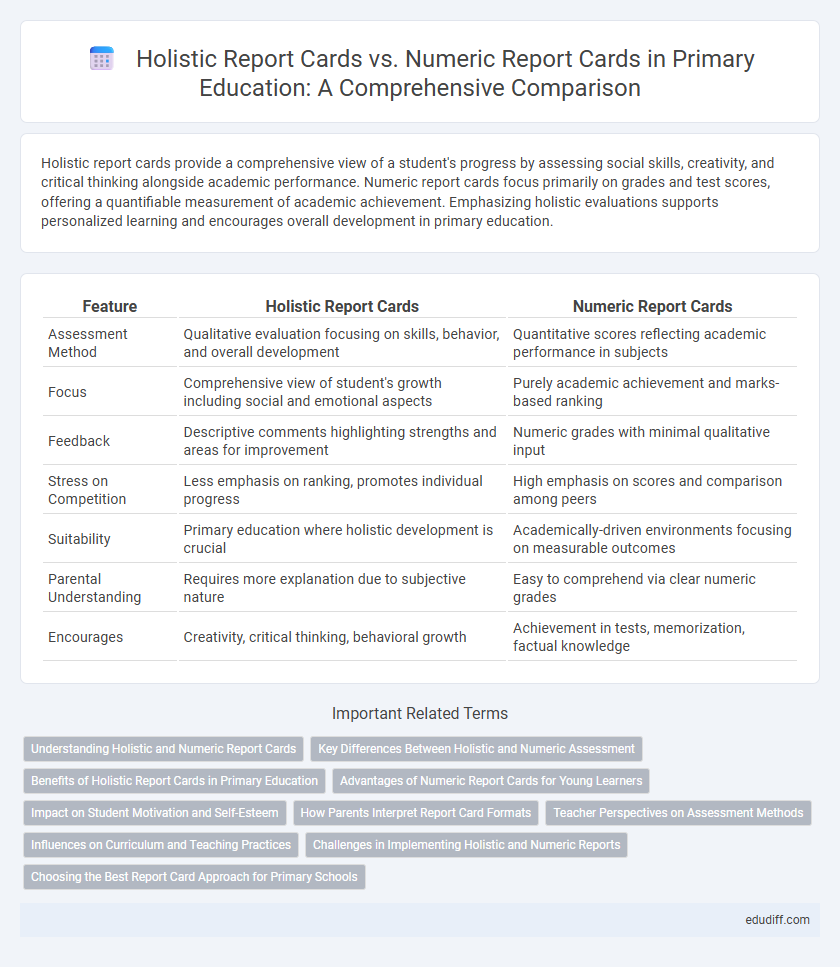Holistic report cards provide a comprehensive view of a student's progress by assessing social skills, creativity, and critical thinking alongside academic performance. Numeric report cards focus primarily on grades and test scores, offering a quantifiable measurement of academic achievement. Emphasizing holistic evaluations supports personalized learning and encourages overall development in primary education.
Table of Comparison
| Feature | Holistic Report Cards | Numeric Report Cards |
|---|---|---|
| Assessment Method | Qualitative evaluation focusing on skills, behavior, and overall development | Quantitative scores reflecting academic performance in subjects |
| Focus | Comprehensive view of student's growth including social and emotional aspects | Purely academic achievement and marks-based ranking |
| Feedback | Descriptive comments highlighting strengths and areas for improvement | Numeric grades with minimal qualitative input |
| Stress on Competition | Less emphasis on ranking, promotes individual progress | High emphasis on scores and comparison among peers |
| Suitability | Primary education where holistic development is crucial | Academically-driven environments focusing on measurable outcomes |
| Parental Understanding | Requires more explanation due to subjective nature | Easy to comprehend via clear numeric grades |
| Encourages | Creativity, critical thinking, behavioral growth | Achievement in tests, memorization, factual knowledge |
Understanding Holistic and Numeric Report Cards
Holistic report cards assess students through qualitative feedback, emphasizing skills, behavior, and overall development, which supports a comprehensive view of a child's learning progress. Numeric report cards provide specific grades or scores based on measurable academic performance, offering clear benchmarks for achievement in subjects like math, reading, and science. Understanding these approaches helps educators and parents balance qualitative insights with quantitative data to support effective learning in primary education.
Key Differences Between Holistic and Numeric Assessment
Holistic report cards evaluate a student's overall development by integrating social, emotional, and cognitive skills, offering a comprehensive view of progress beyond mere academic scores. Numeric report cards focus solely on quantifiable test results and grades, emphasizing measurable academic achievement through percentages or letter grades. The key difference lies in holistic assessments fostering a broader understanding of a child's abilities, while numeric assessments prioritize standardized, objective performance metrics.
Benefits of Holistic Report Cards in Primary Education
Holistic report cards in primary education provide a comprehensive assessment by evaluating cognitive, emotional, and social development, fostering a more well-rounded understanding of a child's progress. They emphasize strengths, areas for improvement, and personalized feedback, which supports tailored learning strategies and promotes student self-awareness. This approach enhances communication between teachers, students, and parents, encouraging collaborative efforts to nurture overall growth beyond mere academic performance.
Advantages of Numeric Report Cards for Young Learners
Numeric report cards provide clear, quantifiable feedback that helps young learners understand their academic progress objectively. They simplify goal-setting by offering specific performance metrics, which can motivate students to improve their skills in core subjects. This format also allows parents and educators to track development trends effectively, ensuring targeted support for early childhood education.
Impact on Student Motivation and Self-Esteem
Holistic report cards emphasize qualitative feedback that nurtures student motivation by highlighting individual strengths and areas for growth, fostering a growth mindset and increased self-esteem. Numeric report cards provide clear, quantifiable performance metrics but may inadvertently discourage students by fixating on scores rather than progress. Studies in educational psychology reveal that holistic assessments promote intrinsic motivation and resilience, which are crucial for long-term academic success in primary education.
How Parents Interpret Report Card Formats
Parents interpret holistic report cards as offering a comprehensive view of their child's learning progress, emphasizing social skills, creativity, and emotional development alongside academic achievement. Numeric report cards provide precise, quantifiable grades that facilitate comparison and clear identification of academic strengths and weaknesses. Holistic formats encourage a broader understanding of student growth, while numeric formats focus on measurable academic performance.
Teacher Perspectives on Assessment Methods
Teachers often view holistic report cards as more effective in capturing a student's overall development, emphasizing social, emotional, and cognitive growth beyond mere test scores. Numeric report cards are praised for their clarity and ease of quantifying academic performance, enabling straightforward comparisons and objective evaluation. Many educators advocate for combining both methods to balance qualitative insights with quantitative data, ensuring a comprehensive assessment of primary students' learning progress.
Influences on Curriculum and Teaching Practices
Holistic report cards shape curriculum and teaching practices by emphasizing broad developmental domains such as social skills, creativity, and critical thinking, encouraging educators to adopt more flexible and student-centered approaches. Numeric report cards drive a focus on measurable academic outcomes, often leading to standardized instruction and targeted skill mastery. This divergence affects how educators design lesson plans, assess student progress, and prioritize learning objectives across primary education.
Challenges in Implementing Holistic and Numeric Reports
Implementing holistic report cards faces challenges such as subjectivity in teacher assessments and the increased time required for personalized feedback. Numeric report cards encounter difficulties in accurately reflecting student abilities beyond test scores and often fail to capture social-emotional development. Both systems require extensive teacher training and standardized guidelines to ensure consistency and fairness across diverse classrooms.
Choosing the Best Report Card Approach for Primary Schools
Holistic report cards provide a comprehensive assessment of primary students by evaluating social skills, creativity, and critical thinking alongside academic performance, promoting a balanced view of development. Numeric report cards focus on quantitative scores in core subjects like math and reading, offering clear benchmarks for progress but often missing nuanced aspects of student growth. Choosing the best report card approach for primary schools depends on prioritizing either detailed cognitive metrics or a broader evaluation that supports personalized learning and emotional development.
Holistic Report Cards vs Numeric Report Cards Infographic

 edudiff.com
edudiff.com